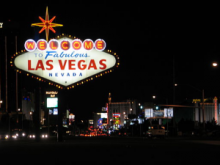Article
Located in southeastern Nevada, the city of Las Vegas is a major American tourist destination famous for its flashy casinos, themed hotels, shopping, and large entertainment venues. Nomadic Anasazi and Paiute Native peoples roamed the area until the arrival of Spaniards in the early 1800s. In 1909, the American town was founded as a small railroad service station built on marshland surrounded with grassy meadows, which are the source of its name (in Spanish: "the meadows"). The water that was once abundant in the valley has now mostly dried up due to extensive pumping, the city is known for its hot desert climate and long spells of drought. Las Vegas grew significantly in the 1930s with the construction of the nearby Hoover Dam but it wasn't until after World War II that major entrepreneurs started investing in the city's developing gambling industry. "The Strip" is a long central stretch of Las Vegas Boulevard that underwent rapid growth in the 1960s and over the past few decades has become the main attraction of the city. The Strip boasts immense, architecturally extravagant hotels and casinos that form a postmodern pastiche of old and new styles, imitations of world-famous sites (such as Venice, Paris, New York, or the Egyptian pyramids), and gaudy restaurants and shopping centers.
"Welcome to the Las Vegas strip, circa 1965" by David Vasquez is licensed under Public Domain.
Manuscripts
References
City of Las Vegas
N.d. History. lasvegasnevada.gov, accessed March 18, 2016.
Encyclopedia Britannica Online
2013 Las Vegas. http://www.britannica.com/EBchecked/topic/330838/Las-Vegas,
accessed January 20, 2015.
Las Vegas Convention and Visitors Authority
2014 Las Vegas Stats and Facts. http://www.lvcva.com/stats-and-facts/, accessed June 26,
2014.

